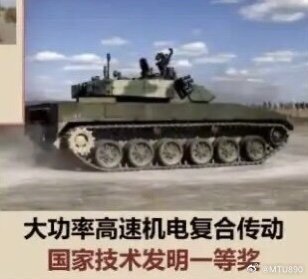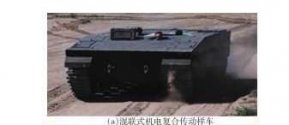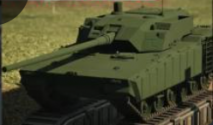You are using an out of date browser. It may not display this or other websites correctly.
You should upgrade or use an alternative browser.
You should upgrade or use an alternative browser.
PLA Next Generation Main Battle Tank
- Thread starter by78
- Start date
Thats my thoughts as well. This is a Chinese Armata style tank. Whats different is China is also developing a new power source for it. Unlike Russia who is playing catch up in this area for Armata, ZTZ-99A already have state of the art current gen engine. We might see a new concept of tanks beyond of Armata's protection innovation. Mobility, automation could be where real innovation is.The turret actually looks smaller while the chassis looks taller for sure. Perhaps, the turret is unmanned?
I suspect the tank will be surprisingly light and agile, similar to ZTQ-15 while having protection exceeds of ZTZ-99A. We know China is testing a 2 man crew set up compensate with automation and data link. This will make tank more compact, therefore more percentage of mass go into armor. Imagine mass right under 50 ton, while having advanced engine and transmission far exceeds any of current MBT. This will make a very mobile tank while retain sufficient protection. But why? Why not copy western tank design of becoming 70 ton to stack even more protection?
I think the idea is overly stacking armor is insufficient for modern battlefield. There are certain threats that more armor will not help protect: guided artillery, top attack atgm, non-line of sight anti tank weapons, drones carry heavy atgm you cannot detect... Instead of overprepare for those just protect yourself against other direct fires and portable anti tank weapons. Takes the weight saved and obtain strategic mobility. If the tank is hit, make sure crews survive. If crews are lost, that is just 2 crews.
Furthermore the enemy of China is no longer Soviet Union that fields powerful tanks on open field. All the potential enemy of China either have bad infrastructure for heavier tanks (Korewa, south asia and south east asia), or require oversea deployment. Those scenarios are not for 70ton tanks. At the same time ZTQ still cannot substitute heavier tanks in firepower and protection.
Thats my thoughts as well. This is a Chinese Armata style tank. Whats different is China is also developing a new power source for it. Unlike Russia who is playing catch up in this area for Armata, ZTZ-99A already have state of the art current gen engine. We might see a new concept of tanks beyond of Armata's protection innovation. Mobility, automation could be where real innovation is.
I suspect the tank will be surprisingly light and agile, similar to ZTQ-15 while having protection exceeds of ZTZ-99A. We know China is testing a 2 man crew set up compensate with automation and data link. This will make tank more compact, therefore more percentage of mass go into armor. Imagine mass right under 50 ton, while having advanced engine and transmission far exceeds any of current MBT. This will make a very mobile tank while retain sufficient protection. But why? Why not copy western tank design of becoming 70 ton to stack even more protection?
I think the idea is overly stacking armor is insufficient for modern battlefield. There are certain threats that more armor will not help protect: guided artillery, top attack atgm, non-line of sight anti tank weapons, drones carry heavy atgm you cannot detect... Instead of overprepare for those just protect yourself against other direct fires and portable anti tank weapons. Takes the weight saved and obtain strategic mobility. If the tank is hit, make sure crews survive. If crews are lost, that is just 2 crews.
Furthermore the enemy of China is no longer Soviet Union that fields powerful tanks on open field. All the potential enemy of China either have bad infrastructure for heavier tanks (Korewa, south asia and south east asia), or require oversea deployment. Those scenarios are not for 70ton tanks. At the same time ZTQ still cannot substitute heavier tanks in firepower and protection.
There have also been recent articles from the US how they are looking at a lighter and more mobile future main battle tank to succeed the M1 family (likely including currently in development variants) in tactical, operational and strategic ways, as well as being more survivable.
I'm not sure if a future PLA MBT will be as light as ZTQ-15 given that one is only in the 30t class, but certainly it is likely to be at least a bit lighter than ZTZ99A.
I think it will be heavier than 96A but lighter than base 99. Maybe 45-48 ton. About same as a T-90. Soviet designs like T-72 had similar concerns for mass and strategic mobility, and we are about to see its return, but without the compromise of T-72 series.There have also been recent articles from the US how they are looking at a lighter and more mobile future main battle tank to succeed the M1 family (likely including currently in development variants) in tactical, operational and strategic ways, as well as being more survivable.
I'm not sure if a future PLA MBT will be as light as ZTQ-15 given that one is only in the 30t class, but certainly it is likely to be at least a bit lighter than ZTZ99A.
Think in China's perspective. Most of the super old tanks are gone. ZTZ-96 series are next to replace. What can it do to retire ZTZ-96A? ZTZ-99A is a great tank, but it struggle to fill the role of 96A. Some places are simply unsuitable for 99A's mass. ZTQ-15 is not a replacement for 96A either. It is a specialist tank. 96A is a workhorse that keeps traditional MBT roles, too dangerous for ZTQ-15. That is why I think China want a lighter next gen MBT.
The great thing about having a lighter MBT is you can unify both 99A and 96A's role. If need to China can up armor the tank to create a heavy variant. You can't cut down a heavy tank like 99A, but you can make lighter tank heavier. No point going lighter than 45 ton because then you just use ZTQ-15. It will not retire any time soon.
Last edited:
Assuming that box next to the driver is a cover to shield against the elements like the ones on the ZBL-08, then it looks like it has 2 hatches.A screenshot of an academic paper that shows different hybrid drivetrain configurations (series and parallel hybrids) being tested. Does anyone have access to the paper?

An announcement on a first place prize awarded to a high-power and high-speed electromechanical transmission (?), which might or might not be related to the image above:

I think it will be heavier than 96A but lighter than base 99. Maybe 45-48 ton. About same as a T-90. Soviet designs like T-72 had similar concerns for mass and strategic mobility, and we are about to see its return, but without the compromise of T-72 series.
Think in China's perspective. Most of the super old tanks are gone. ZTZ-96 series are next to replace. What can it do to retire ZTZ-96A? ZTZ-99A is a great tank, but it struggle to fill the role of 96A. Some places are simply unsuitable for 99A's mass. ZTQ-15 is not a replacement for 96A either. It is a specialist tank. 96A is a workhorse that keeps traditional MBT roles, too dangerous for ZTQ-15. That is why I think China want a lighter next gen MBT.
The great thing about having a lighter MBT is you can unify both 99A and 96A's role. If need to China can up armor the tank to create a heavy variant. You can't cut down a heavy tank like 99A, but you can make lighter tank heavier. No point going lighter than 45 ton because then you just use ZTQ-15. It will not retire any time soon.
It's not as straightforward as up-armoring a 45-ton MBT to have the same protection as a 60-ton MBT. Physics works the same everywhere and if you try to save 15 tons, sacrifices have to be made.
The fundamental difference between today's 45-50 ton Soviet MBTs and 60-65 ton NATO MBTs is armor layout. The Soviet T-series have a very basic composite layout, usually several layers of steel and other materials like Textolite arranged in a simple sandwich. In some models (e.g. T-72A) there are no composites at all, just layers of high-hardness steel with air spacing.
On the other hand, NATO MBTs like the Abrams have full-scale NERA arrays built into the hull, which have many steel-rubber-steel sandwiches arranged in a complex geometry. The advantage is much better base armor protection compared to Soviet tanks. The downsides are that it takes much more volume, is more difficult to repair, and due to the resulting huge turrets which also contain a bustle ammo rack, necessitates a very large hull, adding lots of mass.
Soviet tanks try to compensate for their poor base armor by using ERA. This is an elegant and lightweight solution that, after decades of improvement, can defeat kinetic and HEAT rounds. But at the end of the day, this is just compensating for a fundamental weakness. No matter how much you try to up-armor a Soviet tank, it will still be a simple composite sandwich plus ERA, and only as effective as a NATO tank's armor without ERA. If NATO tanks ever adopt ERA (unlikely) then their armor would be unmatched, with the exception of the 99A which we think already uses NERA arrays + heavy ERA on the turret.
Going back to the 96A and 99A, why do these mass differences exist? The Type 96A is in reality a Type 88C. It inherits the hull of the 88 series which is Soviet in design philosophy - lighter than their NATO counterparts but protection is much more basic, and this is the trade-off. On the other hand, the 99 was largely a clean-sheet design. We don't know what they put in the hull armor, but if it has NERA arrays instead of the 96A's simple composite sandwich, then that explains the extra weight.
There is simply no way to cut down on this weight without either sacrificing some sort of protection, or reducing the size of the vehicle, which is why unmanned turrets are the future. By moving the crew into the hull, the turret can be much smaller and protection requirements lower, meaning that all the armor can be concentrated on the hull instead, with full NERA arrays plus heavy ERA. This is how you make a 45-ton heavy MBT.
The main cause of the difference in weight between Soviet and Western MBTs of the late Cold War is the autoloader. You put in the autoloader, and you need one less crewman, and thus reduce the volume of the turret. This significantly reduces weight. Using a robotic turret is just the next step after that. By eliminating the volume for crew in the turret altogether you can reduce tank weight even more.
It's a bit more than that.The main cause of the difference in weight between Soviet and Western MBTs of the late Cold War is the autoloader. You put in the autoloader, and you need one less crewman, and thus reduce the volume of the turret. This significantly reduces weight. Using a robotic turret is just the next step after that. By eliminating the volume for crew in the turret altogether you can reduce tank weight even more.
Compare MBTs like M1A1HA and T-72B side by side.
The M1A1 HA has a significantly more capable suspension that can also be changed from a torsion bar type to a hydropneumatic type. It has a higher hull floor, much thicker hull armour all around, and longer/heavier tracks. The long turret variant has 800mm armour thickness, more sophisticated and capable electronics, and a larger external bustle rack.
The T-72B has a one-piece stamped hull that sits much lower than the HA. It's also more cramped. The autoloader is directly on the hull floor and doesnt intrude into any crewmen station. It has barely any room for additional stowage. The engine and transmission are also designed specifically to minimize spatial and weight penalties. The turret is extremely small, the 2A45 gun has barely any mantlet and also barely any depression!. Most T-tanks relied on an external Luna active IR spotlight instead of intergral passive IR like on later M60s and had no white light! Finally, shitty ergonomics. Though you could make a case for M60's crap-tier driver station...


